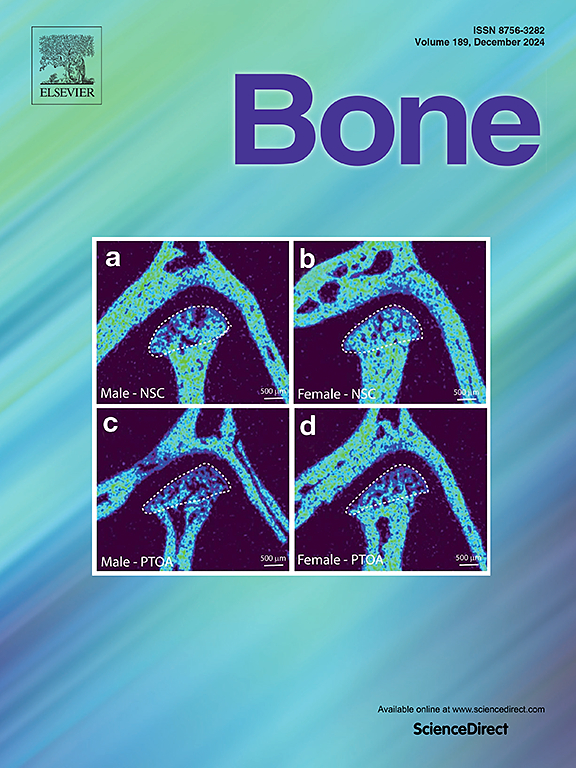使用3D-DXA和TBS的男性和女性骨骼结构参数的年龄相关差异:文京健康研究
IF 3.5
2区 医学
Q2 ENDOCRINOLOGY & METABOLISM
引用次数: 0
摘要
背景:影像技术的最新进展,包括骨小梁评分(TBS)和3D-DXA,使骨质疏松症的综合骨结构评估超越了传统的骨矿物质密度(BMD)测量。然而,与年龄相关的骨结构差异仍不清楚。方法:使用来自Bunkyo健康研究的数据,我们分析了1372名参与者(662名男性,710名女性)的股骨近端骨结构参数和1053名参与者(500名男性,553名女性)的腰椎骨结构参数,年龄为65-84 岁。参数包括腰椎TBS和股骨近端测量(3D-Shaper),包括骨小梁、皮质和整体的体积骨密度、皮质厚度和每个骨区域的表面骨密度。年龄组比较(65-69岁、70-74岁、75-79岁和80-84 岁)采用Kruskal-Wallis检验并进行Bonferroni校正。结果:在男性中,只有股骨近端皮质厚度显著下降,特别是在80-84岁年龄组,与65-69和70-74岁年龄组相比(P )结论:女性在所有参数中都表现出广泛的变化,而男性主要表现出皮质厚度的变化,这表明需要针对性别的方法来评估骨质疏松症和骨折风险预测。本文章由计算机程序翻译,如有差异,请以英文原文为准。
Age-related differences in bone structural parameters using 3D-DXA and TBS in men and women: The Bunkyo Health Study
Background
Recent advancements in imaging technology, including trabecular bone score (TBS) and 3D-DXA, enable comprehensive bone structure assessment beyond traditional bone mineral density (BMD) measurements in osteoporosis. However, age-related differences in bone structure remain unclear.
Method
Using data from the Bunkyo Health Study, we analyzed bone structural parameters in 1372 participants (662 men, 710 women) for the proximal femur and 1053 participants (500 men, 553 women) for the lumbar spine, aged 65–84 years. Parameters included TBS of the lumbar spine and proximal femur measurements (3D-Shaper), including volumetric BMD of trabecular, cortical, and integral, cortical thickness, and surface BMD in each bone region. Age group comparisons (65–69, 70–74, 75–79, and 80–84 years) were performed using Kruskal–Wallis test with Bonferroni correction.
Results
In men, only cortical thickness significantly decreased in the proximal femur regions, particularly in the 80–84 age group compared to the 65–69 and 70–74 age groups (−2.3 %, P < 0.05). In women, all parameters significantly decreased (P < 0.001), especially in the 80–84 age group—cortical thickness (−3.9 %), cortical surface BMD (−9.6 %), cortical volumetric BMD (−4.0 %), and trabecular volumetric BMD (−8.4 %)—compared to the 65–69 age group. TBS was significantly lower in women aged 70–74 and 80–84 years compared to those aged 65–69 years (P < 0.001); however, no significant changes were observed in men.
Conclusions
Women showed widespread changes across all parameters, whereas men exhibited primarily cortical thickness changes, suggesting the need for sex-specific approaches for osteoporosis assessment and fracture risk prediction.
求助全文
通过发布文献求助,成功后即可免费获取论文全文。
去求助
来源期刊

Bone
医学-内分泌学与代谢
CiteScore
8.90
自引率
4.90%
发文量
264
审稿时长
30 days
期刊介绍:
BONE is an interdisciplinary forum for the rapid publication of original articles and reviews on basic, translational, and clinical aspects of bone and mineral metabolism. The Journal also encourages submissions related to interactions of bone with other organ systems, including cartilage, endocrine, muscle, fat, neural, vascular, gastrointestinal, hematopoietic, and immune systems. Particular attention is placed on the application of experimental studies to clinical practice.
 求助内容:
求助内容: 应助结果提醒方式:
应助结果提醒方式:


